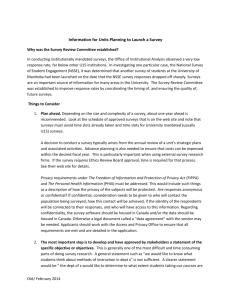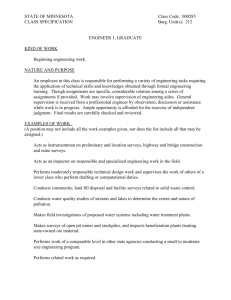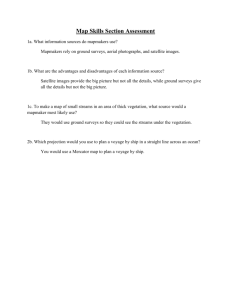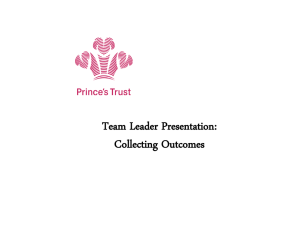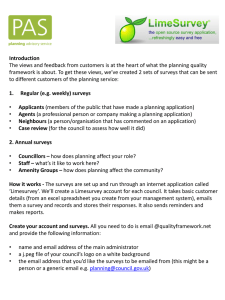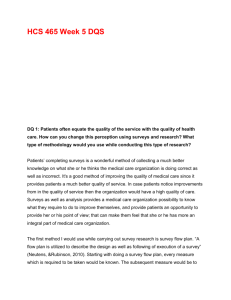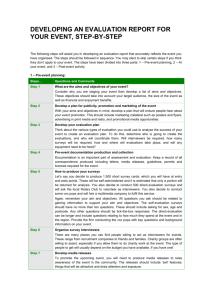Preparing an event survey guidelines
advertisement
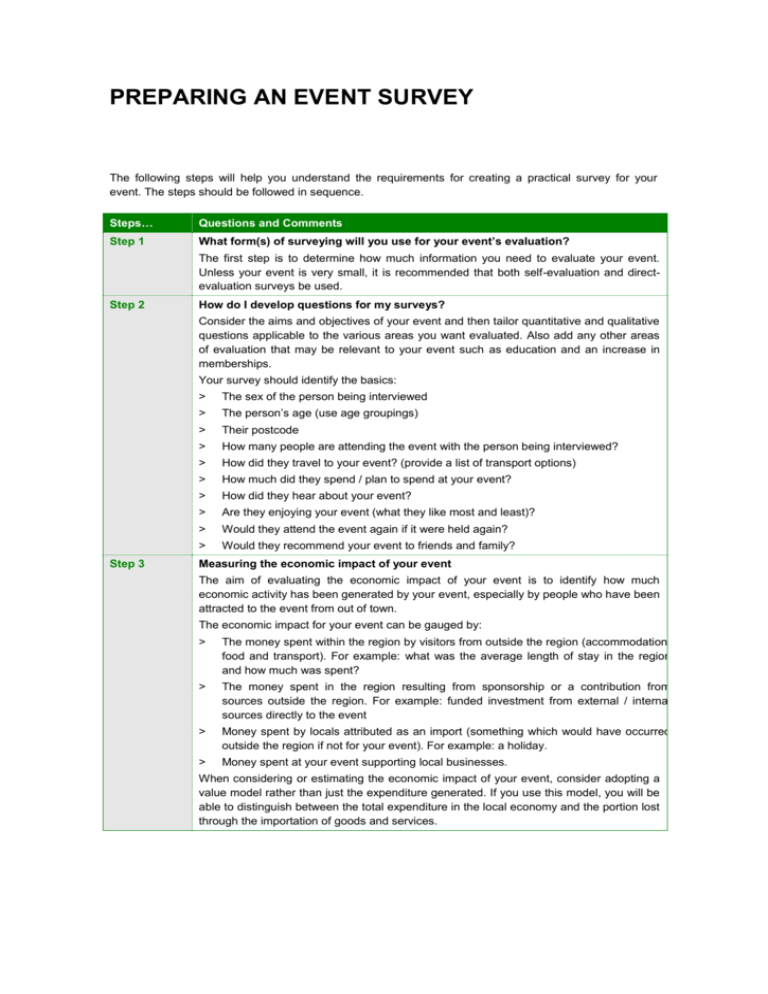
PREPARING AN EVENT SURVEY The following steps will help you understand the requirements for creating a practical survey for your event. The steps should be followed in sequence. Steps… Questions and Comments Step 1 What form(s) of surveying will you use for your event’s evaluation? The first step is to determine how much information you need to evaluate your event. Unless your event is very small, it is recommended that both self-evaluation and directevaluation surveys be used. Step 2 How do I develop questions for my surveys? Consider the aims and objectives of your event and then tailor quantitative and qualitative questions applicable to the various areas you want evaluated. Also add any other areas of evaluation that may be relevant to your event such as education and an increase in memberships. Your survey should identify the basics: Step 3 > The sex of the person being interviewed > The person’s age (use age groupings) > Their postcode > How many people are attending the event with the person being interviewed? > How did they travel to your event? (provide a list of transport options) > How much did they spend / plan to spend at your event? > How did they hear about your event? > Are they enjoying your event (what they like most and least)? > Would they attend the event again if it were held again? > Would they recommend your event to friends and family? Measuring the economic impact of your event The aim of evaluating the economic impact of your event is to identify how much economic activity has been generated by your event, especially by people who have been attracted to the event from out of town. The economic impact for your event can be gauged by: > The money spent within the region by visitors from outside the region (accommodation, food and transport). For example: what was the average length of stay in the region and how much was spent? > The money spent in the region resulting from sponsorship or a contribution from sources outside the region. For example: funded investment from external / internal sources directly to the event > Money spent by locals attributed as an import (something which would have occurred outside the region if not for your event). For example: a holiday. > Money spent at your event supporting local businesses. When considering or estimating the economic impact of your event, consider adopting a value model rather than just the expenditure generated. If you use this model, you will be able to distinguish between the total expenditure in the local economy and the portion lost through the importation of goods and services. Step 4 Assessing media, publicity and advertising Evaluating the media, publicity and advertising used to promote your event provides a comparison to the return. Have you exceeded or past visitation numbers? Have people traveled from non-local areas after seeing or hearing about your event? The media, publicity and advertising used to promote your event can be assessed by: > The number of articles, interviews, and photographic shoots conducted prior to your event. (This can be measured via column centimeters – i.e. number of cm multiplied by the cost per column cm). > An increase in public awareness of your event arising from publicity or advertising activities. > Post event promotional coverage. For example: did the event receive positive media coverage and were there any ‘in hindsight’ type stories As part of your overall events planning, you should have established some key criteria for measuring the success of your event (profit, numbers attending etc). Unless you can specifically identify the source of your data (e.g. total event registrations, the number and demographics of total respondents to a questionnaire or survey,) your evaluation of the events success is likely to be subjective, and not necessarily realistic. Step 5 Measuring the tourism impact The aim in evaluating the tourism impact for your event is to determine its value as a draw card to people from outside the region. This has the potential to have a range of financial, social and cultural benefits including an increase in local employment opportunities or income. By understanding the tourism impact, you will also be better positioned to attract sponsorship or funding, should your event be held in the future. To gauge the tourism impact of your event, you need to: Step 6 > Determine how many people attended the event from non-local areas. > Identify the number of people who attended your event instead of traveling to another region. For example: on a holiday or day-out. > Determine what was the economic impact from people who visited the area to attend your event? For example: what did they spend on accommodation, food etc? Evaluating visitor appreciation and enjoyment Depending on the aim and objectives of your event, an assessment of the appreciation by those who attended may be the largest factor in evaluating its overall success. A community festival for example, isn’t designed as a moneymaking initiative and is unlikely to have a large tourism draw. The aim is to provide the local community with a safe and enjoyable event. To assess the local appreciation of your event: Step 7 > Determine how long people spent at your event. For example: did they attend for a brief time or did they make your event a daylong activity? > Identify the average number of people who attended. For example: did the person attend by themselves, with a partner only, with their family or with a group? > Rank all the activities and services available at your event for people to score. These should include amenities such as toilets and water through to entertainment and food. For example: use a tick-the-box or numerical score, categorising each item as either excellent, good, average, poor, or don’t know. Practice your survey or do a trial run After you have prepared the questions and are comfortable that you will obtain practical information to evaluate your event, practice your interview using the questions in sequence to see if the order works. Practicing the survey will identify issues such as it being too long. Step 8 How many surveys will be required? Before determining how many surveys will be required, estimate the number of people you anticipate will attend your event as accurately as possible. If the event has not been held before, find out the attendance numbers for other similar events to use as a guide. You should aim to survey the event’s audience randomly. The surveys completed should not be less than 150 surveys. In reality – the more the better! Step 9 Who should I get to conduct the surveys? There are a number of options available to you, dependent on your budget. You could use people from your organising group or volunteers from local clubs or charities, or you could contract professional interviewers. If you need support, the City has a team of surveyors who can be contracted to your event. Contact the Events Unit for more information. Step 10 Where will surveys be conducted or available? Ensure that you have interviewers in locations that will capture all audience demographics. Self-evaluations should be available at the entrance and exit gates and at public service areas such as information desks. Step 11 How do I evaluate the survey results? There are two options to evaluate your surveys. You can contract a research company to provide a comprehensive analysis or you can evaluate the surveys yourself



